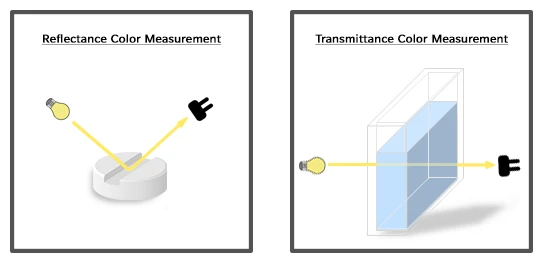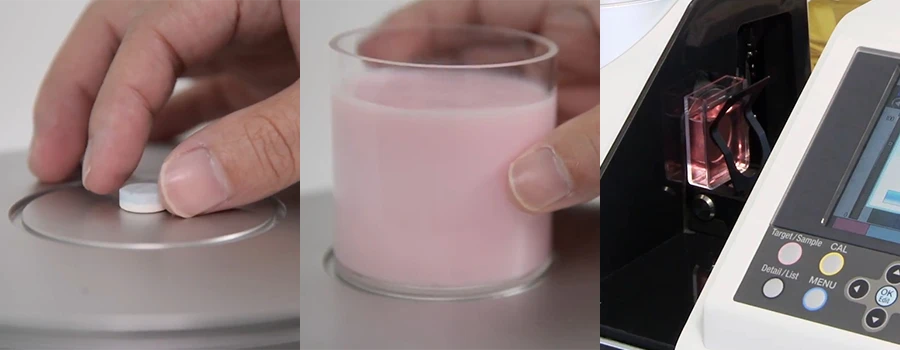การวัดการเคลือบฟิล์มยาและแท็บเล็ตด้วยเครื่องสเปกโตรโฟโตมิเตอร์

เมื่อพูดถึงเรื่องการใช้ยา ปัจจัยหนึ่งที่มักถูกมองข้ามคือสีของยายาเม็ดหรือแท็บเล็ต– แม้ว่าบางคนอาจมองว่าสีเป็นเพียงความสวยงามเท่านั้น แต่จริงๆ แล้วสีนั้นมีจุดประสงค์ที่สำคัญในอุตสาหกรรมยา สีมีบทบาทสำคัญในการรับประทานยาสม่ำเสมอ โดยเฉพาะอย่างยิ่งสำหรับผู้ป่วยที่ต้องรับประทานยาหลายชนิดในช่วงเวลาที่ต่างกันของวัน สีที่แตกต่างกันช่วยให้แยกแยะยาแต่ละชนิดได้ ซึ่งช่วยลดความเสี่ยงที่จะผสมยากัน นอกจากนี้การศึกษาได้แสดงให้เห็นว่าผู้บริโภคเชื่อมโยงสีเฉพาะกับยาบางประเภท ตัวอย่างเช่น เม็ดสีขาวหรือสีน้ำเงินมักถูกมองว่ามีรสขม ในขณะที่เม็ดสีชมพูคิดว่ามีรสหวานมากกว่าเม็ดสีแดง ที่น่าสนใจคือเปลี่ยนสีอาจส่งผลกระทบต่อการรับประทานยาตามใบสั่งแพทย์ของผู้ป่วย ซึ่งอาจทำให้พวกเขาต้องหยุดรับประทานยาทั้งหมด
ปัจจัยสำคัญประการหนึ่งที่ส่งผลต่อสีของยาเม็ดหรือยาเม็ดคือการเคลือบฟิล์ม การเคลือบฟิล์มยาและยาเม็ดเป็นกระบวนการทางเภสัชกรรมที่สำคัญสำหรับรูปแบบยาที่เป็นของแข็งซึ่งมีมาเป็นเวลานาน ชั้นเคลือบบางๆ นี้ใช้กับยาเม็ดและยาเม็ดเพื่อเป็นชั้นป้องกันยา เพื่อให้แน่ใจว่าจะไม่ได้รับผลกระทบจากปัจจัยภายนอก เช่น แสง ความชื้น หรืออากาศ นอกจากนี้ยังทำหน้าที่ปกปิดรสชาติหรือใช้เพื่อความสวยงาม ทำให้เม็ดยาและแท็บเล็ตดูน่าดึงดูดยิ่งขึ้น
การวัดสีเคลือบฟิล์มยาและแท็บเล็ต
ด้วยความก้าวหน้าทางเทคโนโลยีสเปกโตรโฟโตมิเตอร์ได้กลายเป็นเครื่องมือยอดนิยมสำหรับการวัดสีในอุตสาหกรรมยา อุปกรณ์เหล่านี้จะปล่อยแสงไปที่ตัวอย่าง และวัดปริมาณแสงที่สะท้อนหรือส่งผ่านที่ความยาวคลื่นต่างๆ จากนั้นข้อมูลที่ได้จะถูกแปลงเป็นข้อมูลสีเชิงปริมาณ ซึ่งโดยทั่วไปจะแสดงโดยใช้ปริภูมิสีที่กำหนดไว้ เช่นCIE L*A*B*– วิธีการวัดสีนี้ช่วยให้มั่นใจได้ถึงผลลัพธ์ที่แม่นยำและแม่นยำ ซึ่งมีความสำคัญอย่างยิ่งในการใช้งานด้านเภสัชกรรม ซึ่งการแปรผันเพียงเล็กน้อยอาจส่งผลให้เกิดผลลัพธ์ที่สำคัญ
ซัพพลายเออร์ของส่วนเติมเนื้อยา เช่น การเคลือบฟิล์ม มักจำเป็นต้องวัดสีของการเคลือบฟิล์มเพื่อเปรียบเทียบสีต่างๆ เพื่อให้ตรงกับรหัสสีของลูกค้า ในระหว่างการพัฒนาฟิล์มเคลือบสำหรับเม็ดยา จำเป็นต้องสร้างต้นแบบเพื่อให้แน่ใจว่าสีที่เข้ากันอย่างเหมาะสมและสอดคล้องกับข้อกำหนดของลูกค้า ในขั้นแรก ฟิล์มจะถูกวัดในสถานะของเหลวหลังจากผสมสีเสร็จแล้ว จากนั้นจึงผลิตและวัดแผ่นฟิล์ม ซึ่งในที่สุดจะนำไปสู่การวัดสีของเม็ดยาที่เคลือบฟิล์มจริง ในทำนองเดียวกัน การเคลือบฟิล์มสำหรับยาเม็ดยังต้องผ่านกระบวนการและวิธีการวัดสีแบบเดียวกับที่ใช้ในการเคลือบฟิล์มของยาเม็ด ความแตกต่างอยู่ที่ประเภทของการเคลือบที่ต้องการ ไม่ว่าจะเป็นแบบโปร่งใสหรือแบบมีสี
ในการประเมินสีของการเคลือบฟิล์มเม็ดยาหรือยาเม็ด มีสองวิธีหลักๆ ได้แก่ การวัดสีสะท้อนแสง และการวัดสีที่ส่องผ่าน การวัดสีการสะท้อนแสงเป็นวิธีการที่ใช้กันมากที่สุด แม้ว่าการวัดการส่งผ่านแสงสามารถทำได้ตามความต้องการเฉพาะ (เช่นของเหลว, ฟิล์มใส เป็นต้น) ข้อควรพิจารณาที่สำคัญประการหนึ่งเมื่อวัดสีของยาเม็ดหรือยาเม็ดเคลือบฟิล์มคือขนาดและรูปร่าง เนื่องจากขนาดของรูรับแสงที่ใช้ในสเปกโตรโฟโตมิเตอร์สามารถส่งผลกระทบอย่างมากต่อความแม่นยำในการวัด ดังนั้นจึงจำเป็นต้องพิจารณาอย่างรอบคอบเพื่อให้แน่ใจว่าขนาดรูรับแสงสอดคล้องกับเม็ดยาหรือแท็บเล็ตที่กำลังประเมิน

ตัวอย่างภาพประกอบของการวัดสีการสะท้อนแสงและการส่งผ่าน
โซลูชันการวัดสีของ Konica Minolta สำหรับการเคลือบฟิล์มยาและแท็บเล็ต
Konica Minolta Sensing ซึ่งเป็นชื่อที่เชื่อถือได้ในด้านโซลูชันการวัดสี มีเครื่องสเปกโตรโฟโตมิเตอร์และคัลเลอริมิเตอร์ที่หลากหลาย ซึ่งให้การประเมินสีที่แม่นยำและเชื่อถือได้สำหรับอุตสาหกรรมต่างๆ ในจำนวนนี้สเปกโตรโฟโตมิเตอร์ CM-5คือโซลูชันที่ตอบโจทย์สำหรับการวัดสีที่แม่นยำและเชื่อถือได้ในอุตสาหกรรมยา– เทคโนโลยีขั้นสูง ความคล่องตัว และการดำเนินงานที่เป็นมิตรต่อผู้ใช้ทำให้เป็นเครื่องมือสำคัญในการรับรองคุณภาพและความสม่ำเสมอของผลิตภัณฑ์ในอุตสาหกรรมที่มีการควบคุมอย่างเข้มงวดนี้
เครื่องสเปกโตรโฟโตมิเตอร์ CM-5 มีความสามารถในการตรวจวัดที่หลากหลาย รวมถึง CIE L*a*b* ที่ใช้กันอย่างแพร่หลายและดัชนีเฉพาะอุตสาหกรรมอื่นๆ เช่นตำรับยาของยุโรป (EP), ตำรับยาของสหรัฐอเมริกา (USP)–APHA/Hazen และการ์ดเนอร์– เครื่องมือนี้สามารถทำการวัดทั้งการสะท้อนแสงและการส่งผ่านสี ทำให้สามารถประเมินตัวอย่างประเภทต่างๆ ได้อย่างครอบคลุม ตั้งแต่ยาเม็ดเคลือบฟิล์ม ไปจนถึงของเหลวและแผ่นฟิล์ม เครื่องสเปกโตรโฟโตมิเตอร์ CM-5 รองรับช่องรับแสงขนาดต่างๆ ตั้งแต่ Φ3 มม. ถึง Φ30 มม. และมาพร้อมกับอุปกรณ์เสริมต่างๆ เช่น จานเพาะเชื้อ และเซลล์หลอดที่ช่วยให้การนำเสนอและการตรวจวัดตัวอย่างง่ายและสม่ำเสมอ

Spectrophotometer CM-5 การวัดสีของแท็บเล็ต (ซ้าย), ของเหลวทึบแสง (กลาง) และของเหลวโปร่งแสง (ขวา)
นอกจากนี้ ความสามารถของสเปกโตรโฟโตมิเตอร์ CM-5 ยังสามารถปรับปรุงเพิ่มเติมได้ด้วยซอฟต์แวร์การจัดการสีSpectraMagic NXหรือสเปคตร้าเมจิก NX2– ซอฟต์แวร์ช่วยให้การรายงานที่ปรับแต่งได้ การติดตามแนวโน้ม และความสามารถในการสร้างสูตรสีที่กำหนดเองซึ่งปรับให้เหมาะกับความต้องการเฉพาะ วิดีโอนี้ ใช้เพื่อเรียนรู้เพิ่มเติมเกี่ยวกับฟังก์ชันการทำงานที่หลากหลายและยืดหยุ่นของ Spectrophotometer CM-5
หากต้องการความช่วยเหลือในการวัดสีของผลิตภัณฑ์ยาของคุณอย่างถูกต้อง กรุณาติดต่อกับเราเพื่อนัดเวลารับคำปรึกษาฟรีกับทีมผู้เชี่ยวชาญด้านการใช้สีของเรา เราพร้อมมอบโซลูชันที่ดีที่สุดและช่วยเหลือคุณในการเอาชนะความท้าทายในการวัดสี
